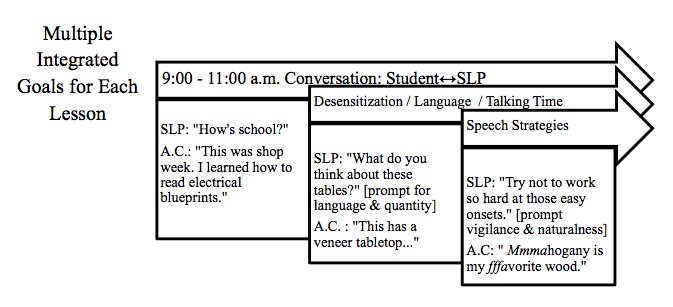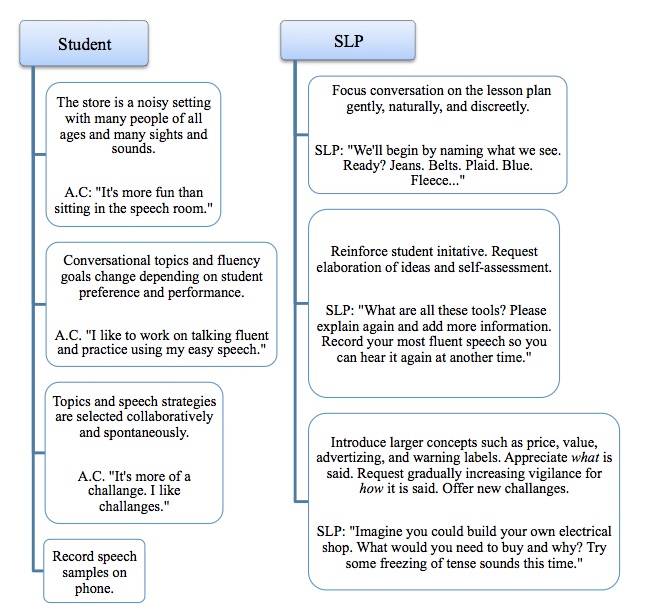Fluency Lesson Ideas for Window Shopping
 |
About the presenter: About the presenter: Judy Butler is a graduate of Brown University (1979) and the University of Connecticut (1981). She also attended the 1992 Fluency Specialist Workshop sponsored by Stuttering Foundation at Northwestern University. She is an ASHA Board Recognized Specialist in Fluency and Fluency Disorders. She has been in private practice since 1991, working exclusively with children who stutter since 1997. Her blog "Comments on Speech Therapy" is at http://butlerspeechtherapy.blogspot.com/. |
 |
About the presenter: A.C. is finishing up the 9th grade at a technical high school as he coauthors this ISAD article. He shares the following information about himself for this conference: My first week of school, I was in a shop called machine tech and there were huge lathes and drill presses and saws and I was not scared to use them. I am in electrical for my main shop. I like to ride BMX bikes. Me and my friends built a bridge to do tricks on. Judith first met A.C. in 2007 and would like everyone to know that he is a friendly, dedicated, and courageous speech therapy student. |
Fluency Lesson Ideas for Window Shopping
by Judy Butler and A.C.
from Massachusetts, USA
This Clinical Nugget is a series of 3 graphics using Microsoft Office Word 2007, SmartArt Graphics. The graphic format reflects the collaborative nature of this work by integrating the student's gift for 3-D thinking with the SLP's preference for written language. This narrative style was also borrowed from a work of fiction (Egan, 2011). All 3 graphics represent a narrative for lessons which A.C. (Student) & J.B. (SLP) are developing as they generalize concepts of fluency therapy to a 'real life' experience -- window shopping. Window shopping is defined in this presentation as browsing the aisles of retail stores looking for products that will inspire conversation. While window shopping, spontaneous dialogue is the primary method for practicing desensitization (Kuster, 2011), scaffolding language & literacy (from the Massachusetts Curriculum Frameworks for English Language Arts and Literacy), focusing on student self-expression (Donaher and Retzinger, 2004), applying fluency enhancing strategies (Ramig and Dodge, 2010) while discussing cognitive and affective issues (Scott, 2010) as needed. Renewed respect for client and clinician input into the therapy process offers support for this innovative approach. (Ratner, 2012) Suggestions are welcome!
![]()


References
Donaher, J. & Reztinger, M. (2004). Therapeutic Listening. International Stuttering Awareness Day Online Conference. Retrieved from http://www.mnsu.edu/comdis/isad7/papers/donaher7.html.
Egan, J. (2010). A Visit from the Goon Squad. NY: Anchor Books. Chapter 12.
Kuster, J.M. (2011, February 15) At Long Last, A Positive Portrayal of Stuttering. The ASHA Leader.
MA Department of Elementary and Secondary Education. (2011). Massachusetts Curriculum Framework for English Language Arts and Literacy, College and Career Readiness Anchor Standards for Speaking and Listening (grades 6-12) p. 60, 1.(c). Retrieved from http://www.doe.mass.edu/frameworks/ela/0311.pdf .
Ramig, P.R. & Dodge, D.M. (2010). The Child and Adolescent Stuttering Treatment Guide. Clifton Park, NY: Delmar Cengage Learning.
Ratner, N.B. (2012). Evidence Based Practice and Practice Based Evidence: Closing the Gap. [DVD] Available from www.stutteringhelp.org . Scott, L.A. (2010). Implementing CBT with School Age Children. [DVD] Available from www.stutterhelp.org.
SUBMITTED: June 25, 2012

